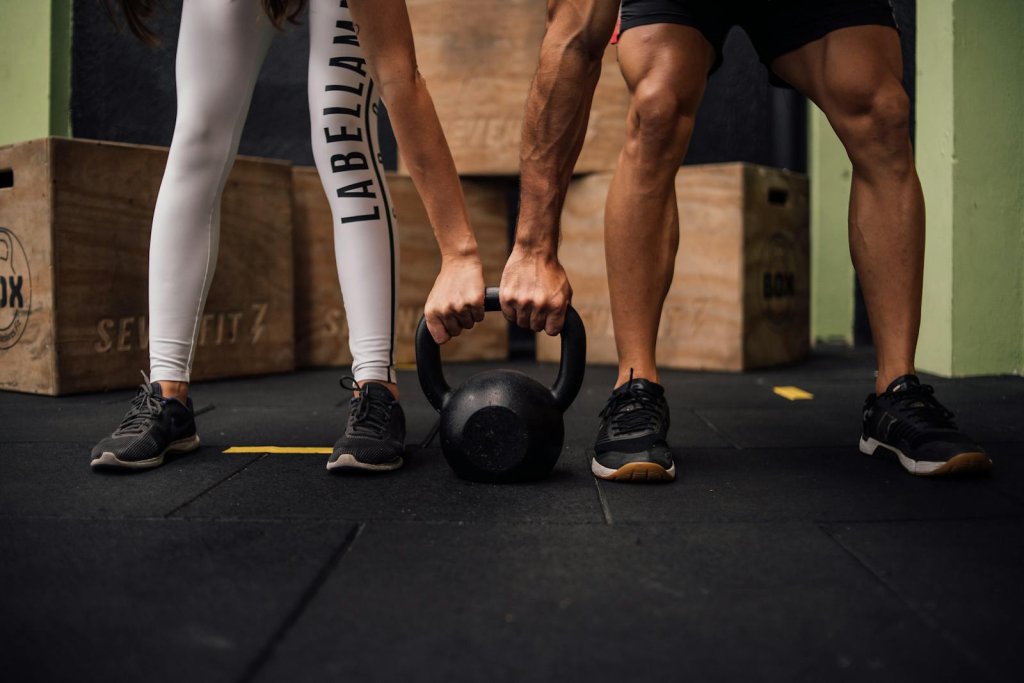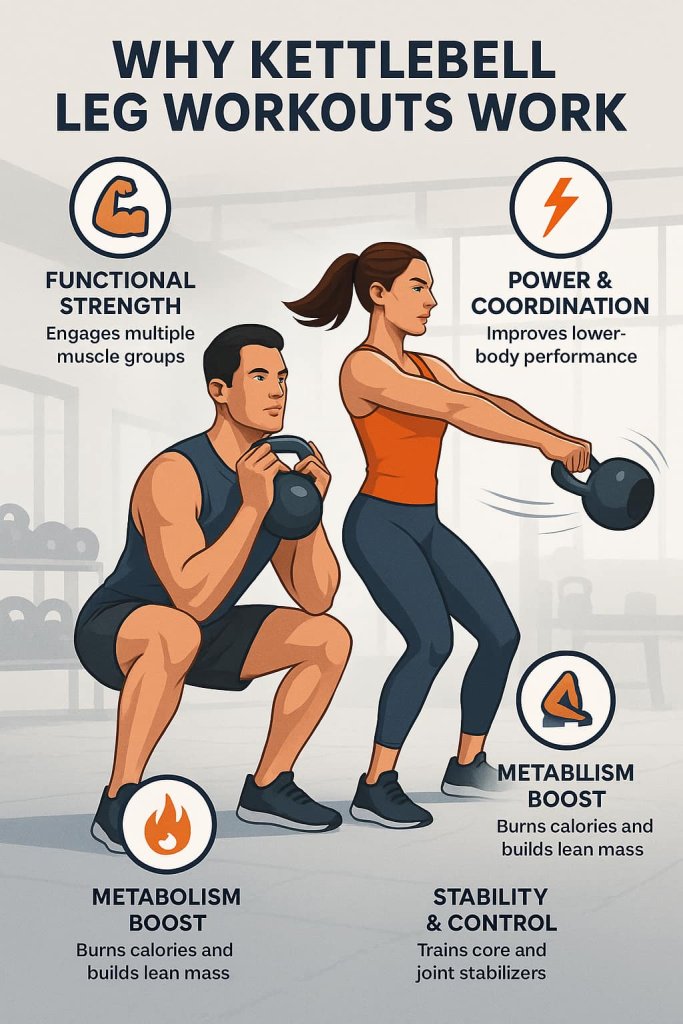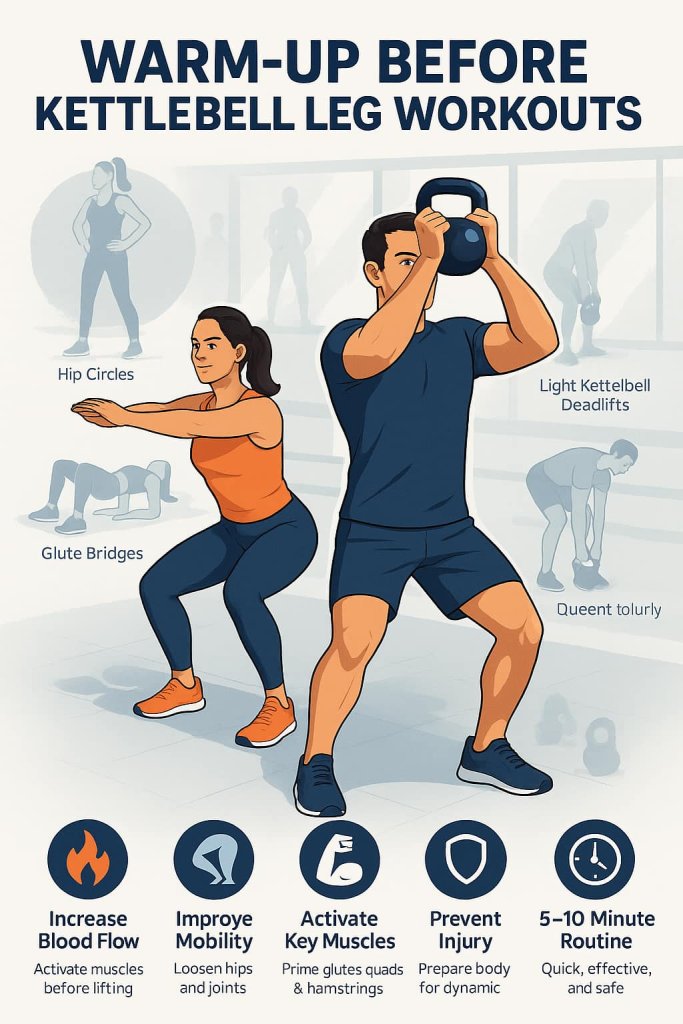Kettlebell leg workouts are one of the most efficient ways to build strength, power, and balance — all while improving mobility and burning calories.
These exercises target your glutes, quads, hamstrings, and calves, enhancing functional movement and athletic performance. Whether you train at home or in the gym, kettlebells offer unmatched versatility for total lower-body development.

Understanding how to use kettlebells effectively for your legs can help you move better, lift heavier, and stay injury-free. Below, you’ll find 22 of the best kettlebell leg exercises for all levels — backed by research and expert recommendations.
Why Kettlebell Leg Workouts Work
According to Experts, kettlebell training engages multiple lower-body muscle groups while improving core stability and balance. Unlike machines, kettlebells require dynamic control — training your muscles and stabilizers simultaneously.

Key benefits include:
- Builds functional strength and balance
- Improves power and coordination
- Enhances mobility and flexibility
- Boosts metabolism and calorie burn
- Strengthens stabilizing muscles to prevent injury
A 2024 study in the Journal of Strength & Conditioning Research found that kettlebell training increased lower-body power output and balance compared to traditional weightlifting routines.
Warm-Up Before Kettlebell Leg Workouts
Always spend 5–10 minutes warming up to prepare your joints and muscles.

Try this quick sequence:
- Bodyweight squats – 10 reps
- Hip circles – 30 seconds each direction
- Kettlebell halos – 5 each side
- Glute bridges – 10 reps
- Light kettlebell deadlifts – 8 reps
22 Best Kettlebell Leg Exercises
Below are the most effective kettlebell leg exercises, organized by movement type for balanced development.
1. Kettlebell Goblet Squat
Why it works:
The goblet squat builds leg strength, balance, and core stability while reinforcing proper squat mechanics. Holding the kettlebell at chest level shifts the weight forward, which encourages an upright torso and deeper hip engagement — ideal for protecting the spine. It’s one of the most beginner-friendly but powerful lower-body kettlebell moves.
Muscles worked: Quads, glutes, hamstrings, erector spinae, core stabilizers.
How to do it:
- Hold the kettlebell by the horns close to your chest, elbows pointing down.
- Set feet slightly wider than shoulder-width.
- Keep chest up, brace your core, and lower until your thighs are parallel or slightly below.
- Push through your heels and squeeze glutes at the top.
Trainer Tip:
Keep your elbows between your knees at the bottom — this ensures proper depth and alignment. If your heels lift off, widen your stance slightly.
2. Kettlebell Deadlift
Why it works:
The deadlift strengthens the entire posterior chain — glutes, hamstrings, and spinal stabilizers — promoting functional power for lifting and running. It trains proper hip hinge mechanics, essential for preventing lower-back strain.
Muscles worked: Glutes, hamstrings, lower back, lats, forearms.
How to do it:
- Place kettlebell between your feet, stand tall, and engage your core.
- Push hips back, keeping shins vertical, and grip the handle.
- Drive hips forward and stand up straight, squeezing glutes.
- Lower with control, hinging at the hips again.
Trainer Tip:
Think “hips back” not “bend down.” This maintains hamstring tension and prevents rounding your spine.
3. Kettlebell Swing
Why it works:
A cornerstone of kettlebell training, the swing enhances explosive hip power, cardiovascular endurance, and calorie burn. It mimics the hip extension used in running and jumping, improving athleticism.
Muscles worked: Glutes, hamstrings, core, erector spinae, grip muscles.
How to do it:
- Stand with feet shoulder-width apart.
- Hinge at hips, swing kettlebell back between legs.
- Snap hips forward, letting momentum swing the kettlebell to chest height.
- Allow it to fall naturally and repeat the rhythm.
Trainer Tip:
Your arms act as guides, not lifters — the power comes entirely from your hips. Keep spine neutral and avoid overextending at the top.
4. Kettlebell Front Rack Squat
Why it works:
This variation adds significant core challenge due to the front-loaded position, improving posture and abdominal engagement. It builds stronger quads and stabilizers essential for balance and lifting efficiency.
Muscles worked: Quads, glutes, core, shoulders, upper back.
How to do it:
- Clean one or two kettlebells into front rack position at shoulder height.
- Keep elbows close to the body and chest upright.
- Squat to full depth, maintaining core tension.
- Drive upward through heels and exhale at the top.
Trainer Tip:
Keep wrists neutral — don’t let kettlebells pull your hands backward. Strong core tension prevents leaning forward.
5. Kettlebell Reverse Lunge
Why it works:
The reverse lunge enhances unilateral leg strength, balance, and coordination. Stepping backward reduces knee stress while engaging the glutes and hamstrings more than forward lunges.
Muscles worked: Glutes, quads, hamstrings, calves, core.
How to do it:
- Stand tall with kettlebells at your sides.
- Step one leg back and lower until both knees form 90°.
- Push through the front heel to stand back up.
- Repeat on the other side.
Trainer Tip:
Don’t let your front knee cave inward — maintain knee tracking over your toes for safety.
6. Kettlebell Step-Up
Why it works:
Step-ups improve unilateral strength, hip drive, and knee stability. They mimic real-life movements like climbing stairs and are excellent for athletic power and balance.
Muscles worked: Quads, glutes, calves, core.
How to do it:
- Hold kettlebells by your sides.
- Step onto a box or bench, pressing through your heel.
- Stand tall without locking knees, then step down slowly.
Trainer Tip:
Keep the leading leg doing the work — avoid bouncing off your back leg.
7. Kettlebell Romanian Deadlift (RDL)
Why it works:
A top move for hamstring and glute development, the RDL builds strength through a controlled eccentric motion. It enhances flexibility and strengthens the lower back.
Muscles worked: Hamstrings, glutes, erector spinae, forearms.
How to do it:
- Stand with feet hip-width apart, knees slightly bent.
- Hold kettlebell close to thighs, hinge at hips.
- Lower until hamstrings stretch, keeping back straight.
- Drive hips forward to return upright.
Trainer Tip:
Maintain constant tension — the kettlebell should stay close to your legs throughout.
8. Kettlebell Bulgarian Split Squat
Why it works:
This move isolates each leg, improving balance and core control. It also increases hip mobility and single-leg strength critical for sports performance.
Muscles worked: Quads, glutes, hamstrings, calves.
How to do it:
- Stand in front of a bench and place one foot behind you.
- Hold kettlebells at your sides.
- Lower back knee toward the ground and rise back up through the front heel.
Trainer Tip:
Keep your front shin vertical to prevent knee strain.
9. Kettlebell Lateral Lunge
Why it works:
Improves hip mobility, strengthens adductors, and develops side-to-side athletic movement.
Muscles worked: Adductors, glutes, quads, core.
How to do it:
- Hold kettlebell at chest height.
- Step wide to one side, bending your knee while keeping the other leg straight.
- Push back to center.
Trainer Tip:
Keep both feet planted and weight evenly distributed.
10. Kettlebell Sumo Deadlift
Why it works:
Targets glutes and inner thighs with a wider stance, reducing back strain while improving hip strength.
Muscles worked: Glutes, hamstrings, adductors, lower back.
How to do it:
- Take a wide stance, feet turned slightly outward.
- Hold kettlebell between your legs.
- Hinge at hips and drive up with glutes and thighs.
Trainer Tip:
Engage your core before each lift to stabilize your spine.
11. Kettlebell Clean
Why it works:
Combines strength and speed, developing explosive hip and leg power. It also improves coordination and full-body control.
Muscles worked: Glutes, hamstrings, traps, core, deltoids.
How to do it:
- Swing kettlebell between your legs, then pull it upward.
- “Catch” it softly at chest level in the rack position.
Trainer Tip:
Keep the motion fluid — avoid letting the kettlebell bang your wrist.
12. Kettlebell Snatch
Why it works:
This high-intensity move builds total-body power, grip strength, and endurance. Great for advanced conditioning.
Muscles worked: Glutes, hamstrings, shoulders, core, grip.
How to do it:
- Perform a swing, then pull kettlebell overhead in one motion.
- Lock your arm at the top, then guide it back down safely.
Trainer Tip:
Master the swing and clean before adding snatches. Use lighter weights first.
13. Kettlebell Curtsy Lunge
Why it works:
Improves glute activation, hip mobility, and rotational balance.
Muscles worked: Glute medius, quads, adductors, stabilizers.
How to do it:
- Hold kettlebell close to chest.
- Step one leg diagonally behind the other.
- Lower into a controlled lunge and return to standing.
Trainer Tip:
Avoid twisting your hips — focus on keeping torso tall.
14. Kettlebell Front Step Lunge
Why it works:
Increases quad and glute engagement through forward motion, improving stability and control.
Muscles worked: Quads, glutes, calves, abs.
How to do it:
- Step forward with one foot, lowering your body until both knees are 90°.
- Push off the front heel to return upright.
Trainer Tip:
Keep your chest lifted and core tight to maintain balance.
15. Kettlebell Single-Leg Deadlift
Why it works:
Improves balance, coordination, and posterior chain activation. Great for athletes needing unilateral strength.
Muscles worked: Glutes, hamstrings, core, stabilizers.
How to do it:
- Stand on one leg, holding kettlebell in opposite hand.
- Hinge forward, keeping hips square.
- Return to standing by contracting glutes.
Trainer Tip:
Move slowly — control and balance matter more than range.
16. Kettlebell Jump Squat
Why it works:
Increases lower-body explosiveness, helping with vertical power and athletic speed.
Muscles worked: Quads, glutes, calves, core.
How to do it:
- Hold kettlebell close to chest.
- Perform a full squat, then jump explosively upward.
- Land softly, absorbing impact with knees bent.
Trainer Tip:
Limit reps (8–10) to maintain form and avoid fatigue-based injury.
17. Kettlebell Side Step Squat
Why it works:
Strengthens outer glutes and thighs while improving lateral agility.
Muscles worked: Glutes, abductors, quads.
How to do it:
- Hold kettlebell at chest height.
- Step laterally and lower into a squat, keeping knees aligned.
- Push back to center.
Trainer Tip:
Maintain continuous tension in your legs — don’t lock knees at the top.
18. Kettlebell Swing to Squat Combo
Why it works:
Combines dynamic power (swing) and controlled strength (squat) for full-leg conditioning.
Muscles worked: Glutes, quads, hamstrings, core.
How to do it:
- Perform one kettlebell swing.
- As it drops, flow directly into a goblet squat.
- Stand tall and repeat smoothly.
Trainer Tip:
Use lighter weight and focus on clean transitions between movements.
19. Kettlebell Front Rack Step Lunge
Why it works:
Integrates balance, core activation, and unilateral strength. The front rack hold challenges posture and breathing control.
Muscles worked: Quads, glutes, abs, shoulders, stabilizers.
How to do it:
- Hold kettlebell in front rack.
- Step forward into a lunge, keeping elbow tight.
- Push off heel to return.
Trainer Tip:
Engage your abs before stepping to stabilize the load.
20. Kettlebell Suitcase Deadlift
Why it works:
Strengthens posterior chain and enhances anti-rotational core strength — key for spinal stability.
Muscles worked: Glutes, hamstrings, obliques, core.
How to do it:
- Stand tall with kettlebell beside one foot.
- Hinge at hips, grip the handle, and lift to standing.
- Lower with control.
Trainer Tip:
Avoid leaning toward the weighted side — keep spine neutral.
21. Kettlebell Figure-8
Why it works:
Improves coordination, balance, and grip endurance while engaging the core and hips.
Muscles worked: Glutes, legs, core, forearms, stabilizers.
How to do it:
- Stand with feet wide, knees slightly bent.
- Pass kettlebell between legs in a figure-8 motion.
- Keep movement smooth and hips stable.
Trainer Tip:
Don’t rush — maintain rhythm and control to keep form tight.
22. Kettlebell Pistol Squat (Advanced)
Why it works:
Builds elite-level strength, flexibility, and balance on each leg. It’s an advanced movement that deeply activates stabilizing muscles.
Muscles worked: Quads, glutes, hamstrings, hip flexors, core.
How to do it:
- Hold kettlebell at chest height for counterbalance.
- Extend one leg forward and squat slowly on the other.
- Press through heel to stand tall.
Trainer Tip:
Use a bench for partial range if you’re learning the movement — prioritize control over depth.
Common Mistakes to Avoid
- Rounding your back during lifts
- Using arms instead of hips in swings
- Holding breath instead of controlled breathing
- Going too heavy too soon
- Skipping warm-up or cool-down
Sample Kettlebell Leg Workout Plan
Beginner (3 days/week):
- Goblet Squat – 3×10
- Deadlift – 3×8
- Reverse Lunge – 3×10 each leg
- Swing – 3×15
Intermediate (4 days/week):
- Front Rack Squat – 4×8
- Bulgarian Split Squat – 3×10 each leg
- RDL – 3×10
- Clean + Squat Combo – 3×12
Advanced (Power Focus):
- Swing – 4×15
- Snatch – 4×8 each arm
- Jump Squat – 3×10
- Pistol Squat – 3×6 each leg
Safety Tips
- Always keep a neutral spine.
- Use a flat, stable surface.
- Progress gradually with weight.
- Breathe steadily throughout.
- Rest 48 hours between intense sessions.
FAQs
1. Can kettlebell workouts replace leg day?
Yes. Kettlebells can build equal or greater strength than machines if used correctly.
2. How often should I train legs with kettlebells?
Aim for 2–3 times weekly, allowing recovery days.
3. What weight should I start with?
Men: 12–16 kg; Women: 8–12 kg depending on experience.
4. Are kettlebell swings enough for legs?
They’re excellent for power, but pair them with squats or lunges for full development.
5. Can I use one kettlebell only?
Yes. Many of these moves (e.g., goblet squat, RDL, clean) work perfectly with one.
6. Are kettlebell workouts good for knees?
When done correctly, they strengthen supporting muscles and reduce knee strain.
7. Do kettlebell leg workouts build muscle or endurance?
Both — depending on load and reps. Heavy weights build muscle; light weights improve endurance.
Conclusion
Kettlebell leg workouts offer a perfect mix of strength, power, and stability — improving athletic performance and functional fitness. Whether you’re training for size, balance, or endurance, these 22 exercises help sculpt strong, mobile legs without machines.
Start with lighter weights, focus on form, and progress gradually for long-term results.
References
- Comprehensive Review (2024): Evidence that kettlebell training improves strength, power, endurance, and postural control — supports overall claims in your intro/benefits.
Enhancing Athletic Performance: A Comprehensive Review of Kettlebell Training - Kettlebell Swing RCT (2012): Six weeks of swings improved half-squat 1RM and vertical jump; strong support for swings as a power move.
Kettlebell Swing Training Improves Maximal and Explosive Strength - Swing Biomechanics (2012): Details the mechanical demands of kettlebell swings vs. back/jump squats — reinforces hip-hinge and power mechanics you coach.
Mechanical Demands of Kettlebell Swing Exercise - Older Adults Hardstyle Program (2022): 3-month supervised kettlebell training improved health-related fitness and was feasible/safe — supports your safety/YMYL sections.
Effects of Supervised High-Intensity Hardstyle Kettlebell Training in Older Adults (BELL Trial) - KB vs. Body-Weight in Obese Men (2024): Both improved body composition and fitness — validates kettlebells as an effective lower-body RT option.
The Effects of Kettlebell Training Versus Resistance (Body-Weight) Training - ACSM Position Stand (Foundational): Evidence-based guidance on progression, volume, intensity for resistance training — anchors programming and safety advice.
ACSM Position Stand: Progression Models in Resistance Training for Healthy Adults - WL vs. Kettlebell for Power (2012): Both increased strength and power; useful context for programming cleans/snatches alongside other modalities.
Effects of Weightlifting vs. Kettlebell Training on Vertical Jump and Strength - Bulgarian Split Squat EMG (2025): sEMG shows targeted activation of glute med/max and quads across BSS variations — perfect for your unilateral/leg-day cues.
Targeted Muscle Activation in Bulgarian Split Squat Variations
